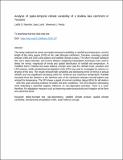Analysis of spatio-temporal climate variability of a shallow lake catchment in Tanzania

View/
Date
2020-04-06Author
Nyembo, Latifa
Larbi, Isaac
Rwiza, Mwemezi
Metadata
Show full item recordAbstract
This study analyzed the trends and spatio-temporal variability in rainfall and temperature, and the length of the rainy season (LRS) in the Lake Manyara catchment, Tanzania, covering a period between 1988 and 2018 using stations and satellite climate product. The Mann-Kendall statistical test, Sen's slope estimator, and inverse distance weighting interpolation techniques were used to detect the trends, magnitude of trends and spatial distribution of rainfall and temperature. A modified Stern's method and water balance concept were used for rainfall onset, cessation and LRS analysis, while standardized precipitation index (SPI) was used to investigate the wetness or dryness of the area. The results showed high variability and decreasing trend (4 mm/y) in annual rainfall, and non-significant increasing trend for minimum and maximum temperature. Rainfall increased from the Western to the Northern part of the catchment whereas reversal pattern was noticed for temperature. The SPI shows a signal of normal condition (about 65%) for all stations – with few years showing evidence of wetter and drier conditions. The LRS showed a decreasing trend indicating a potential negative influence on rain-dependent activities. There is a need, therefore, for adaptation measures such as improving water productivity and irrigation at the farm and catchment level.
